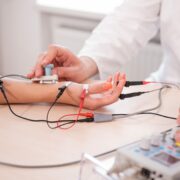
An epiphyseal fracture is a common pediatric injury affecting millions of children yearly. In fact, nearly 15% of all childhood fractures are from growth plate injuries. If not adequately treated, this fracture type can have long-lasting consequences, affecting the child’s future growth and development. As a parent, understanding the causes, symptoms, and treatment options for epiphyseal fractures can help you take the necessary steps to ensure your child receives the best care possible.
What Is an Epiphyseal Fracture?
An epiphyseal fracture, or growth plate epiphysis, is a type of bone fracture that affects the growing part of a child’s bone. These plates are found at the end of long bones in children and adolescents, and they are responsible for bone growth and development.
When a child’s bone is still growing, it is composed of bone and cartilage. Over time, the cartilage hardens into bone, and the growth plate disappears. However, until this process is complete, the growth plate is vulnerable to injury. When a child suffers an epiphyseal fracture, it means that the bone has broken through the growth plate, which can disrupt the process of bone growth and development.
 How Does an Epiphyseal Fracture Occur?
How Does an Epiphyseal Fracture Occur?
The growth plate is the weakest part of the bone and is more susceptible to injury than the surrounding areas. The growth plate is vulnerable to shear forces when the bone is twisted or subjected to direct impact. This can cause the bone plate to break, leading to an epiphyseal injury.
Sports injuries are a common cause of epiphyseal fractures in children. Playing high-contact or high-impact sports such as basketball, soccer, or football can put children at risk of suffering a fracture. Falls are also a frequent cause of injury, especially among younger children still learning to walk and run.
Other factors can increase a child’s risk of experiencing this type of fracture, such as age, sex, and overall health. Boys, for instance, are more likely to suffer epiphyseal fractures than girls. Children who are overweight or obese may also be at greater risk of injury due to the added stress placed on their bones.
Why Are Epiphyseal Fractures Common in Children?
Epiphyseal fractures are relatively common in children because their bones are still developing. Children have softer bones than adults, making growth plate fractures common. As a result, parents, caregivers, coaches, and medical professionals must take extra precautions to protect children from injuries that can lead to epiphyseal fractures.
Moreover, children’s activities and hobbies often put them at risk of trauma that can cause epiphyseal fractures. For example, sports involving jumping, quick movements, and physical contact can stress bones and lead to injury. Participating in high-impact activities without proper instruction and supervision may increase the risk of epiphyseal fractures.
Another reason why epiphyseal fractures are common in children is that they may experience falls or accidents while learning to walk and run. Children can quickly lose their balance and fall from high surfaces, like a bed or a countertop. Falls may result in fractures, especially if the child falls onto an outstretched hand or arm. Children who participate in activities that require running or jumping also have a higher risk of developing stress fractures.
How Are Epiphyseal Fractures Treated?
The growth plate fracture healing time depends on the severity of the injury and the child’s age, overall health, and other individual factors. Nonsurgical treatment is typically used for less serious injuries, while surgery may be necessary for severe cases.
Nonsurgical treatment for epiphyseal fractures generally involves immobilization of the affected area. The length of immobilization can vary, but it typically lasts 3 to 6 weeks. A cast or splint may be used to keep the area stable and promote healing. Pain and anti-inflammatory drugs may also be prescribed to manage symptoms and reduce swelling.
For more severe epiphyseal fractures, surgery may be necessary. Surgical treatment may involve pins, screws, or other fixation devices to hold the bone fragments in place. The surgeon may need to reposition the bone fragments to ensure proper alignment, and the fixation devices can help stabilize the area during the healing process.
After surgery, the child will be monitored closely and given pain medication and antibiotics as needed. The length of the post-operative recovery period depends on the extent of the injury and the type of surgery performed. Physical therapy is typically recommended to help restore mobility and strength to the affected area.
If your child has experienced an epiphyseal fracture, we encourage you to schedule an appointment with us at EmergeOrtho—Triangle Region. Or, call us anytime at (919) 220-5255.







